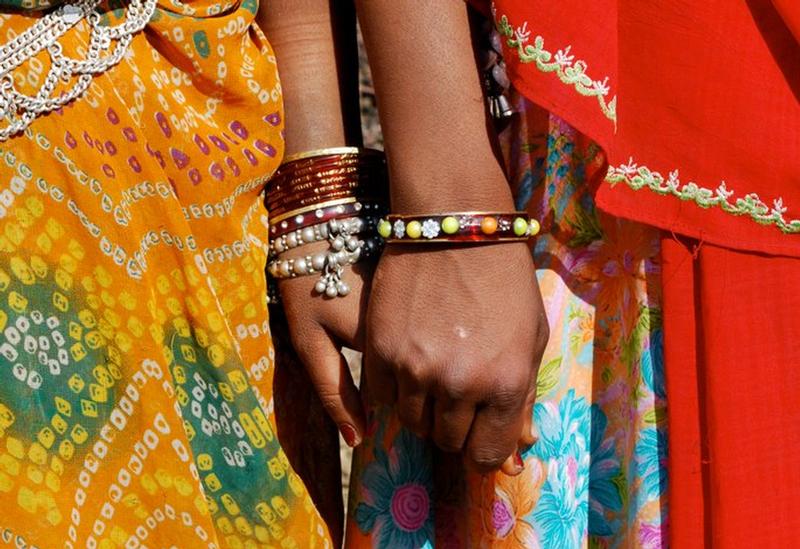Love in Law – The Indian Supreme Court decides in favour of LGBT persons
How to cite this publication:
Vikram Kolmannskog (2018). Love in Law – The Indian Supreme Court decides in favour of LGBT persons. Bergen: Chr. Michelsen Institute (CMI Brief 2018:06)
On 6 September 2018, the Indian Supreme Court delivered a 493-pages-long verdict on LGBT rights and love. “Navtej Singh Johar v. Union of India” is arguably one of the most progressive and comprehensive verdicts that the world has seen in this field of law till date. In the following, I will highlight a few important aspects of the verdict, making extensive use of quotes to convey a sense of the compassionate and cosmopolitan spirit of the Indian Supreme Court judges. (“LGBT” is the term used in the verdict, and therefore the one I will be using here.)
Colonisation and criminalisation
Section 377 of the Indian Penal Code (1860) reads as follows:
377. Unnatural Offences –
Whoever voluntarily has carnal intercourse against the order of nature with any man, woman or animal, shall be punished with imprisonment for life, or with imprisonment of either description for a term which may extend to ten years, and shall also be liable to fine. Explanation- Penetration is sufficient to constitute the carnal intercourse necessary to the offence described in this section.
The law was introduced by the British colonisers in 1860 and is influenced by Victorian morality. As Justice Chandrachud says, “India’s anti-sodomy law was conceived, legislated and enforced by the British without any kind of public discussion. So abhorrent was homosexuality to the moral notions which he espoused, that Macaulay [who drafted the law] believed that the idea of a discussion was repulsive.” Although vague in wording, “carnal intercourse against the order of nature” has mostly been understood to mean non-procreative sex, including anal and oral sex. In the words of Justice Chandrachud again, “Section 377 is based on a moral notion that intercourse which is lustful is to be frowned upon. It finds the sole purpose of intercourse in procreation. In doing so, it imposes criminal sanctions upon basic human urges […]” While everyone having sex that is not potentially procreative could be targeted, the law has mainly worked as a criminalisation of homosexuality.
While section 377 has not been much enforced by courts in post-Independence India, it has continued to have negative effects on LGBT Indians. In 2001, a petition was filed by the Naz Foundation, challenging the law. They felt it was an impediment in their HIV/Aids-prevention work. Since then the mobilisation against section 377 has grown steadily and become much broader, and it has been a long, winding road in the legal system. The first landmark verdict came in 2009 when the Delhi High Court “read down” section 377 in “Naz Foundation v. NCT of Delhi and others”. Immediately after that some conservatives, including Suresh Kumar Koushal, appealed the case, however. In 2013, the Supreme Court decided that it was up to Parliament whether any changes to the law should be made or not, thereby effectively recriminalising homosexuality, in “Suresh Kumar Koushal and another v. Naz Foundation and others”. Since then, review petitions, curative petitions and other petitions, including that of Navtej Singh Johar, have been filed. We have also had two landmark verdicts that did not concern section 377 directly but were still highly relevant: In 2014, the Supreme Court recognised the rights of transgender persons in “NALSA v. Union of India and others”. And in 2017, the Supreme Court, in “Puttaswamy v. Union of India”, clarified that privacy is a fundamental right and that the “Koushal”-verdict was a “discordant note” in its jurisprudence. Finally, on 6 September 2018, the Supreme Court, in “Navtej Singh Johar v. Union of India”, concluded that LGBT Indians are entitled to equal citizenship and full constitutional protection.
After introducing section 377 in India, the British introduced similar legislation in other colonies. The law is still in effect in many of the ex-colonies, and in some it is more actively used in persecution of LGBT persons. This is one reason why “Navtej Singh Johar” is of importance globally.
The Indian Constitution and equal citizenship
The Indian Constitution was adopted in 1949 and became effective on 26 January 1950. Its chief architect was the Dalit lawyer and leader Dr Ambedkar, and it is coloured by his progressive views. While the Supreme Court judges also look to international human rights law and developments in other countries, their emphasis in “Navtej Singh Johar” is on the Indian Constitution. Their conclusion is that section 377 is not in line with the Constitution’s fundamental rights protections, more specifically article 14 (equality before the law), article 15 (non-discrimination), article 19 (including freedom of speech), and article 21 (right to life, which includes right to privacy and dignity). The judges strike down section 377 insofar as it criminalises sex between consenting adults. They spell out their different routes to this conclusion in four concurring judgments.
An important point of law is the judges’ understanding of the right to privacy. The framing of the LGBT struggle as one of right to privacy has not been unproblematic. Section 377 mainly impacted lower class persons, including many sex workers, who were breaking the law in public. But the Supreme Court judges follow the “Puttaswamy”-verdict of 2017, which gave an expansive interpretation of privacy. According to Justice Malhotra, “It now incorporates the ideas of spatial privacy, and decisional privacy or privacy of choice.” Justice Chandrachud specifies even more what this must mean in the present case: “The right to sexual privacy, founded on the right to autonomy of a free individual, must capture the right of persons of the community to navigate public places on their own terms, free from state interference.”
While many describe the verdict as a decriminalisation of homosexuality, it is worth noting the words of Justice Chandrachud: “Decriminalisation is a first step. The constitutional principles on which it is based have application to a broader range of entitlements.” LGBT persons are entitled to full constitutional protection, including equality and non-discrimination. This may eventually entail recognition of same-sex partnerships and marriage, anti-discrimination legislation in workplaces, and more.
Saying sorry
The verdict begins with Chief Justice Misra quoting Goethe: “I am what I am, so take me as I am”. The mobilisation against section 377 in India has not been restricted to litigation and lawyers but has been broad and included artists, academia, activists, and media. The verdict reflects this by referring to fact-finding reports, narratives of persecution, academic writing, poetry, and more. It shows inclusiveness in both form and content, a value that is arguably the best of both Indian and queer culture.

The judges are clearly moved by the suffering of the LGBT community, referring to experiences of the petitioners and other Indians but also to people outside of India and in the past, including Oscar Wilde and Alan Turing. Their compassion is clear from both the content and the tone of the verdict. It contrasts with previous verdicts. Referring to LGBT rights, the judges of the “Koushal”-verdict in 2013 wrote about “so-called rights” of “a minuscule minority”. Even the “NALSA”-verdict of 2014, which was important in establishing strong rights for the trans community, is coloured by pity rather than true compassion and recognition of responsibility.
In “Navtej Singh Johar”, Justice Malhotra goes so far as to state that “History owes an apology to the members of this community and their families, for the delay in providing redressal for the ignominy and ostracism that they have suffered through the centuries.” It makes us think of other important apologies made for causing historic injustice such as the German nation to the Jews. In “Navtej Singh Johar” the judges take responsibility for the wrongs committed and seek to atone for it by clearly spelling out how things must become better today and in the future for LGBT persons. The verdict applies in India, but their words have a universal appeal.
A battle for all
As mentioned above, the mobilisation against section 377 has been a broad mobilisation. LGBT Indians have allied with the women’s movement and others, and have emphasised intersectionality and the connections between various struggles. This is also reflected in the verdict. As Justice Chandrachud says, “Section 377 criminalises behaviour that does not conform to the heterosexual expectations of society. In doing so it perpetuates a symbiotic relationship between anti-homosexual legislation and traditional gender roles.”
The judges see the LGBT struggle as part of a necessary feminist struggle to disrupt traditional gender roles and hierarchies.
The LGBT mobilisation has also been formulated as part of a wider mobilisation for the right to love, whether it is same-sex love or love across castes and communities. Insisting on a right to love can radically transform societies which are still divided based on caste, religion, class and other grounds. As Justice Chandrachud says, “What links LGBT individuals to couples who love across caste and community lines is the fact that both are exercising their right to love at enormous personal risk and in the process disrupting existing lines of social authority […] [T]he right to love [is] not just a separate battle for LGBT individuals, but a battle for all.”
Transforming society
While the framing of the LGBT issue has been mainly in terms of rights, some opponents have brought up arguments based on morality and religion. One response to that has been that inclusiveness and diversity of sexual and gender expressions have a long history in India and that section 377 is imperialist in origin. In “Navtej Singh Johar” the judges don't engage much in this discourse. In a footnote, Justice Chandrachud refers to the work of Ruth Vanita and Saleem Kidwai, saying “More than 2,000 years of Indian literature [demonstrates] that same-sex love has flourished, evolved and been embraced in various forms since ancient times.” What matters to the judges when it comes to morality is “constitutional morality”, a concept first introduced by Dr Ambedkar. The judges quote him, saying, “Constitutional morality is not a natural sentiment. It has to be cultivated.” Justice Chandrachud goes on to say, “Constitutional morality requires that all the citizens need to have a closer look at, understand and imbibe the broad values of the Constitution, which are based on liberty, equality and fraternity.”
According to Chief Justice Misra, “the purpose of having a constitution is to transform society”. This is a task vested in the state, the judiciary, and in the citizen. With regards to the situation of LGBT Indians, a lot of work remains to be done. Justice Chandrachud asks civil society to continue to address prejudices and realise full equality for LGBT persons. He also makes an appeal to mental health professionals in particular to “take this change in the law as an opportunity to re-examine their own views of homosexuality”. Justice Nariman orders the Union of India to give “wide publicity to the judgment” and conduct “sensitisation and awareness training for government officials and in particular police officials […]”
Also important is the concept of non-retrogression spelled out by the judges, that rights once recognised cannot be taken away. But there is never any real guarantee for this, of course. We have seen backlash before. The best guarantee is perhaps the transformation of society that the judges ask for and the LGBT movement and its allies have worked for and must continue to work for in various ways.
Cases mentioned in the paper
“Naz Foundation v. NCT of Delhi”, 160 (2009) DLT 277. Decided 2 July 2009. (Also referred to as “Naz”)
“Suresh Kumar Koushal and another v. Naz Foundation and Others”, (2014) 1 SCC 1. Decided 11 December 2013. (Also referred to as “Koushal”)
“National Legal Services Authority v. Union of India and Others”, Writ Petition (Civil) No. 400 of 2012 and Writ Petition (Civil) No 604 of 2013. Decided 15 April 2014. (Also referred to as “NALSA”)
“Justice K. S. Puttaswamy (Retd.) and Anr. v. Union of India and others”, Writ Petition (Civil) No. 494 of 2012. Decided 24 August 2017. (Also referred to as “Puttaswamy”)
“Navtej Sing Johar and Others v. Union of India”, Writ Petition (Civil) No. 76 of 2016. Decided 6 September 2018. (Also referred to as “Navtej Singh Johar”)
Further reading
Kolmannskog, V. (2015). Including the Queer in India: The Development of Sexual and Gender Minorities Rights Inside and Outside of Indian Courts. Indian Journal of Socio Legal Studies IV (1).
Kolmannskog, V. (2016). No Going Back. A case study of sexual and gender minorities in India and their legal mobilisation. Advances in Social Sciences Research Journal 2 (8).
Narrain, A. (2018). Right to Love: Navtej Singh Johar v. Union of India – A Transformative Constitution and the Rights of LGBT Persons. Bangalore: Alternative Law Forum.
Narrain, A. and Gupta, A. (eds.) (2011). Law like Love: Queer Perspectives on Law. Delhi: Yoda Press.
Omkar, K. (2018). India’s LGBTQ Victory Is a Beacon of Hope for the World. Advocate, 10 September 2018.
Sheikh, D. (2018). By protecting the expression of love and intimacy, the SC has protected the right to love. Hindustan Times, 10 September 2018.
For a detailed history of the case, including legal documents, analysis, and media coverage, also visit 377.orinam.net
Bio
Vikram Kolmannskog (b. 1980, Oslo) is a lawyer, socio-legal scholar, gestalt psychotherapist, and writer.





